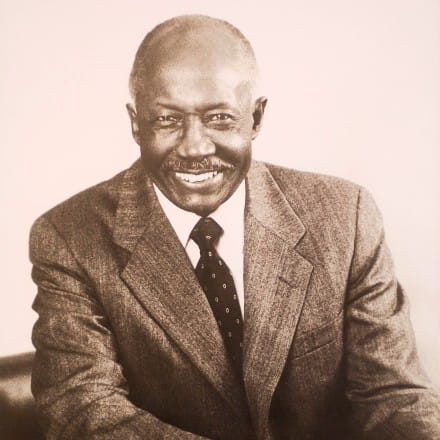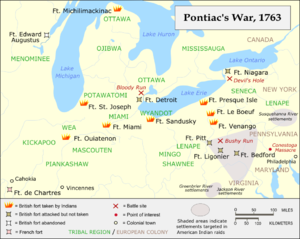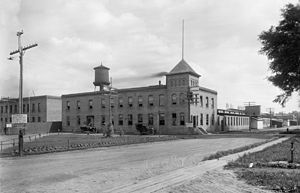Daniel Frank Gerber (May 6, 1898 – March 16, 1974) was an American manufacturer of baby food.
Gerber began urging his father to begin the production of strained baby foods at the family cannery in 1927. Daniel and his wife Dorothy had an ill baby named Sally. Dan’s wife suggested that he persuade his father to begin making and selling at their canning company strained baby foods. Gerber with his father did some extensive research on this new concept. They contacted nutritional experts, distributed many samples, and conducted market research interviews before launching their product. The idea of strained baby foods was not entirely new, but the long-held American tradition was that babies generally were given a liquid diet until they were about a year old. It was risky to introduce this new concept to the marketplace as they had no idea how mothers would react to this new idea. This enterprise became the Gerber Products Company.
In 1928 their canning company started an advertising campaign in Good Housekeeping, Parents Magazine, the Journal of the American Medical Association, and other magazines. Their task was to convince parents to adopt new feeding concepts. The campaign worked and into the 1930s the canning company expanded its baby food lines.
At Gerber’s death in 1974 the company claimed it was the world’s largest baby-food manufacturer.
Some people think Dorothy Scott Gerber, Daniel’s wife, should get credit for developing the baby food operations. Tired of straining foods for her own children, it occurred to her that if the Fremont Canning Company could puree tomatoes, it could also puree fruits and vegetables. Fremont was the predecessor to Gerber Products; the name was changed in 1941.
Mrs. Gerber, a native of Ithaca, Michigan, who married Daniel Gerber in 1923, liked the resulting strained fruits and vegetables and, more important, so did her 7-month-old daughter Sally. The new baby food was priced at 15 cents, which until then had been obtainable largely through drug stores at 40 to 60 cents each. Word quickly spread of the new baby food products, and grocery stories avidly stocked them. Initial offerings included strained peas, carrots, spinich, prunes, and vegetable soup.

In 1928, Gerber sponsored a contest to find a baby picture to use in their ads. The winning sketch was submitted by Dorothy Hope Smith. Ann Turner, the adorable baby in the sketch, would become known as the Gerber baby.
In 1939, Gerber introduced the first baby food cereal.
In 1951, Gerber becomes the first baby food company to advertise on television..
In 1963, Gerber introduces the safety button cap to help mothers determine whether products had been tampered with and was one of the first companies to use the “Better if Used Before” date on their products.
In 2007, Nestle acquired Gerber, which was only appropriate since Henri Nestlé, a pharmacist, was asked to look in on a neighbor’s child who couldn’t breastfeed. The baby thrived on the special mixture Henri created. Soon, Nestlé’s innovation—the world’s first infant food—was being sold throughout Europe, and the first infant food company, Farine Lactée Henri Nestlé, was launched in 1867.
Sources:
Daniel Frank Gerber wikipedia entry
Gerber History and Heritage website

Richard H. Austin was a man of firsts. Not only was he the first black Michigander elected to statewide office, other than the Michigan Supreme Court, he also was Michigan’s longest-serving secretary of state, holding the office from 1970 through 1994. He was also Michigan’s first black certified public accountant, earning his degree from the Detroit Institute of Technology, and he was the first black Wayne County auditor. We can thank him for vehicle registration tabs, which allow us to replace stickers every year instead of the whole license plate, and for mail-in registration renewals. He also helped make voter registration and plate renewal simultaneous.
Sources: Michigan Department of Technology, Management & Budget (DTMB), Michigan Department of Transportation, Senate Fiscal Agency.
Justin A. Hinkley, “Murray who? Meet state office buildings’ namesakes”, Lansing State Journal, October 27, 2015.
Michael Berry was born in Highland Park. His parents, Lebanese immigrants, attempted to return to their native country in 1930, but because of an economic depression — one worse than in the U.S. — they returned to Michigan and settled in Dearborn, according to a biography about Berry on the Michigan State University College of Law website.
He graduated from Fordson High School in 1938, obtained an undergraduate degree from Wayne State University — Wayne College at the time — and attended the Detroit College of Law. He opened a legal practice upon his graduation in 1950.
Berry, a Democrat, ran and won a seat on the Wayne County Road Commission in 1967. During his 16 years on the Board, he played a large role in expanding Detroit Metropolitan Airport.
Source: Gus Burns, Michigan’s first Muslim lawyer, Michael Berry of Dearborn, dies at 95, MLive, October 25, 2015.
On May 6, 1945, Robert Clark Seger was born in Dearborn. He’s known better as Detroit music icon and Rock and Roll Hall of Famer Bob Seger. Over his more than 40-year career, he has sold over 50 million albums, none better than Night Moves, but some prefer Like A Rock or Old Time Rock and Roll. And then there’s We’ve Got Tonight
Source : Detroit Historical Society Facebook page
For more information, see Bob Seger Wikipedia Entry and Rock and Roll Hall of Fame Inductee Bob Segar
Also see Brian McCollum, “Bob Seger and company: 50 years in the books”, Detroit Free Press, March 22, 2015.
Lansing Car Assembly was a General Motors automobile factory in Lansing, Michigan. It contained two elements, a 1901 automobile plant in downtown Lansing, and the 1920 Durant Motors factory on Lansing’s Far Westside.
The Lansing plant was the longest-operating automobile factory in the United States when it closed on May 6, 2005, and one of General Motors last assembly plants where vehicle bodies were made at one plant, and then trucked to another plant to be finished] General Motors began demolition of the plant in the spring of 2006, and demolition was completed in 2007. A new plant at nearby Lansing Grand River Assembly, which began production in 2001, as well as the Delta Township called Lansing Delta Township Assembly assumed some operations when it began production in 2006.
Lansing Car Assembly (LCA) began in 1901 when Ransom E. Olds moved his Olds Motor Works to the city. He set up his plant on the site of the fairgrounds next to the Grand River. This plant in downtown Lansing would later be known as Lansing Car Assembly – Chassis Plant.
Olds Motor Works (pictured between 1905 and 1920)
The plant along Verlinden Avenue, on Lansing’s border with Lansing Township, opened in 1920 as a factory for Durant Motor Works. After the demise of Durant in 1931, the plant remained closed until GM purchased it in 1935. It restarted production for GM’s Fisher Body division, later becoming the Buick–Oldsmobile–Cadillac factory. Its final name was Lansing Car Assembly – Body Plant.
The last cars that Lansing Car Assembly produced were the Chevrolet Malibu/Chevrolet Classic, Oldsmobile Alero, and Pontiac Grand Am, which was the final vehicle built there. The plant built the very last Oldsmobile, a 2004 Alero.
LCA was regularly ranked among the most productive automobile assembly plants in North America. In 2002, it was ranked the number one most productive assembly plant in North America by The Harbour Report, the auto industry’s leading measurement of plant efficiency.
Source :
On May 6, 2010, from 7 a.m. until past midnight, more than 10,000 Detroit Tigers fans, some who waited more than eight hours in line at Comerica Park, paid their respects to the beloved broadcaster Ernie Harwell.
The open casket was placed near the ballpark’s life-sized statue of the Hall of Famer, depicting the announcer with a microphone in his hand, along with the inscription, “The Tigers’ broadcasting legend and masterful storyteller for 42 seasons.”
Source: Nationalpastime.com
The State of Superior. The Upper Peninsula, plus, at various times, parts of Wisconsin, Minnesota and Illinois. This new state was the vision of a separatist movement that began in the 1820s, when some U.P. residents wanted to form their own state.
Other names considered over the years for the proposed state included Chippewa, Huron, Huronia and Clover-Land. The official movement faded away in the late 1970s, although you still occasionally see a bumper sticker supporting the cause.
And the issue was also brought up in again in 2012 by the Marquette County Board of Commissioners over taxation issues.
For the full article, see Zlati Meyer, “You haven’t lived here until … You visit the State of Superior”, Detroit Free Press, June 26, 2011.
Also see :
Superior, a state for the north country / by James L. Carter through MelCat. A second edition is also available.
Lost States: True Stories of Texlahoma, Transylvania, and Other States That Never Made It.
Peggy Walsh-Sarnecki, “51st state? Yoopers are talking up secession from Michigan again”, Detroit Free Press, May 6, 2012.

A Great War Chief of the Three Fires Confederacy and leader of the Anishinabe people. This Chief’s actual name was Boon i wuk, which means “Thunderbirds Landing Upon the Earth.” Today we know of him as Chief Pontiac. Source: Diba Jimooyung. Published by the Saginaw Chippewa Indian Tribe of Michigan and the Ziibiwing Cultural Society. Mount Pleasant, Michigan. 2005.
During the 1760’s, Pontiac organized a large alliance of tribes throughout Michigan, Ohio, Indiana, and Illinois rise up in a war against the British.
He led the efforts that captured 8 out of 11 British Forts between May 16 – June 20, 1763, including:
- Fort Miami (Fort Wayne, Indiana)
- Fort Quiatenon (Lafayette, Indiana)
- Fort St. Joseph (Niles, Michigan)
- Fort Michilimackinac (Mackinaw City, Michigan)
- Fort Sandusky (Sandusky, Ohio)
- Fort Presque Isle (Erie, Pennsylvania)
- Fort Verango (Franklin, Pennsylvania)
- Fort Le Boeulf (Pennsylvania)

Unfortunately, his coalition was unable to capture Fort Detroit, Fort Niagra, and Fort Pitt.

In the eighteenth century, Michigan was the battleground for several conflicts between Native Americans and Europeans. Pontiac’s Rebellion, fought between 1763 and 1766, was one of the most significant of these wars. Throughout much of the 1700s, the British and the French fought over control of North America. But in 1763 Britain finally defeated France and the French surrendered control of Canada to Britain. The United Kingdom had defeated the French, but not France’s Indian allies. The British soon angered many Native Americans. Where the French had been content to trade and maintain friendly relations with the Indians, the British treated them contemptuously. They built forts in Native American territory, suspended the traditional custom of gift giving, and allowed white settlers to take Native American lands.
The Siege….
By April of 1763, many Indians felt that it was time to retaliate. A secret council was held near Detroit.
Note: In a famous council on April 28, 1763, Pontiac urged listeners to rise up against the British. (19th century engraving by Alfred Bobbett).
The Odawa chief Pontiac and other Indian leaders agreed to go to war with the British. Pontiac coordinated the plan to attack Detroit with the Ojibwe, Pottawatomie, Wyandot, and other Indian groups. The coalition attacked Fort Detroit on May 7, 1763, but were unable to defeat the garrison, despite beseiging the fort for much of the year. Nine of the eleven forts they attacked fell.
What made the difference? Fortunately for the besieged, at the outbreak of hostilities, the schooner Huron and the sloop Michigan, the first British ships built on Lake Erie, were anchored in front of the fort and their guns were able to keep the Indians at bay on the river side. In addition, even though the Indians were able to capture one convoy of bateaus at Point Pelee and a few others on the Detroit River, the Huron and the Michigan were able to keep the supply lines open and provide protection for another convoy of bateaus. Without any assistance from the French, Pontiac was forced to give up his siege of Detroit by the end of October when the French refused to come to his aid.
The following year, the British sent an army into Ohio and another into the Great Lakes region. The war continued, but in 1766 Pontiac accepted a peace treaty and was pardoned by the British. Pontiac’s revolt failed to defeat the British Empire, but it did achieve many goals important to Native Americans. The British outlawed new white settlement west of the Appalachian ridge and reinstated the practice of gift giving. Pontiac and the other Native Americans who had fought for their homes and cultures had brought a period of stability and peace to the region.
For more information, see Nathanial Hale, Pontiac’s War: the Great Indian Uprising against the English in 1763, Wynnewood, PA, Hale House, 1973, available at the Central Michigan University Library.
Michigan Historical Calendar, courtesy of the Clarke Historical Library at Central Michigan University.
Fort Pontchartrain du Détroit or Fort Detroit
Additional Sources:
The siege of Detroit in 1763: the Journal of Pontiac’s Conspiracy, and John Rutherfurd’s Narrative of a captivity / Milo Quaife. Also available online to the MSU community.
Pontiac’s War : its causes, course, and consequences / Richard Middleton. New York : Routledge, c2007.
War under heaven : Pontiac, the Indian Nations & the British Empire / Gregory Evans Dowd. Baltimore : Johns Hopkins University Press, 2002.
Ernest J. Lajeunesse, The Windsor Border Region: Canada’s Southernmost Frontier (A Collection of Documents). Toronto: The Champlain Society.
Lyman James Briggs (May 7, 1874 – March 25, 1963) was an American engineer, physicist and administrator. He was a distinguished director of the National Bureau of Standards during the Great Depression and chairman of the Uranium Committee before America entered the Second World War. The Lyman Briggs College at Michigan State University is named in his honor.
Briggs was born on a farm in Assyria, Michigan, near Battle Creek. He was the eldest of two brothers in a family that descended from Clement Briggs, who arrived in America in 1621 on the Fortune (Plymouth Colony ship), the first ship to follow the Mayflower. He grew up in an outdoor life with duties to attend such as would be found on an active farm in the late 19th century. He went to the
Hailing from humble farming origins, Lyman Briggs entered Michigan Agricultural College at the age of 15. Without any secondary education prior to testing into the university, few would believe that Briggs would become one of the nation’s leading multi-disciplinary scientists. Briggs went on to graduate with a degree in agriculture, but soon discovered a passion for physics.
These core interests lead Briggs to the forefront of innovation in many scientific fields. While leading the U.S. Department of Agriculture’s Physics Laboratory, Briggs founded the science of soil physics, a discipline based on his extensive background in ecology, biology and physics.
Eventually, Briggs’ expertise in physics placed him on the government’s radar. In October 1939, shortly after the discovery of uranium fission, he was called upon to lead a covert operation called the Uranium Committee. President Franklin Roosevelt entrusted Briggs with discovering the potential for atomic power. Despite personal adversity and a lack of funding, Briggs’ research went on to become the foundation of the Manhattan Project. In recognition of his contributions to the war effort, Briggs was awarded the Medal of Merit by President Truman in 1945.
Having lived a life full of discovery and never ending quest for answers, it is no surprise that Michigan State University named a college in his honor, a fitting tribute for a man who accomplished so much.
Sources:
Atomic Spartan Exceeds Expectations. Homecoming Headlines
Believe it or not, but in 2008, divers explored the wreck of the Lusitania, situated eight miles off the coast of Ireland. On board, the divers found approximately four million U.S.-made Remington .303 bullets. The discovery supports the German’s long-held belief that the Lusitania was being used to transport war materials. The find also supports the theory that it was the explosion of munitions on board that caused the second explosion on the Lusitania.
Sources:
Jennifer Rosenberg, “Sinking of the Lusitania”, ThoughtCo.com
Jon Backus, Collections up Close: Object of the Week, May 7, 2013.




